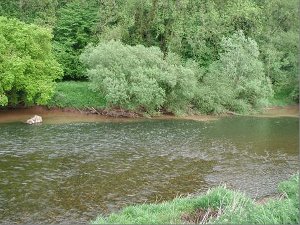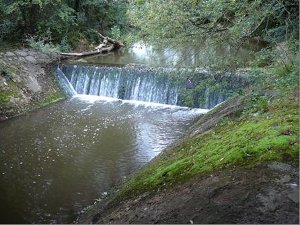The Monmouthshire, Olway and Trothy (MOAT) Project
Starting in September 2012, this project extends the type of work being carried out in Herefordshire's WHIP2 into Monmouthshire.
Olway
WUF's 2009 survey of the lower Usk tributaries found that the Olway, although clear of barriers, suffered from the effects of agricultural pollution. Water Framework Directive (WFD) failures for salmonid fish, macrophytes, phytobenthos and phosphate, in the presence of good levels of invertebrates, strongly suggest the effects of diffuse pollution, such as run off from farm yards, degraded habitat and elevated sediment levels. These are very common problems in the Olway catchment.
Success in mitigating diffuse pollution is derived from engagement with the entire farming community. The project will meet the parish councils and the local schools (which most of the farmers' children or grandchildren attend) will also be involved. With this level of engagement, the uptake and contribution to our challenge fund for farm works is significantly greater.


During MOAT, all the farmers within the Olway catchment will be visited and offered a free and confidential assessment. 50 will have full farm risk assessments and plans will be developed that will improve Water Body status. Where required, a quick and easy-to-access grant pool is available to bring about the proposed changes. Historically farm plans have focussed on other issues such as increasing outputs and diversity but seldom specifically water quality.
The project will reduce loadings of phosphate and fine sediment and the risk of diffuse pollution occurring from each farm, improving fisheries and water bodies downstream. At least 6km of riparian fencing will also be erected to reduce riparian erosion and restore in stream habitat.
Trothy
Surveys conducted by WUF and APEM of the Trothy (a lower Wye tributary, joining at Wyesham) found that the principal pressures are from agricultural diffuse and point source pollution, habitat degradation and elevated sediment levels as a result of unregulated stock access to river banks. There is also one significant barrier to fish migration on the main stem of the lower Trothy, with others on the lower reaches of the Cwmcarfan, Hendre and Wachan brooks, preventing them being used as trout and salmon nursery areas.
In the Trothy catchment the Environment Agency's officers are visiting all the farmers and will be responsible for reducing sediment and diffuse pollution while WUF will be responsible for restoring 7km of stream habitat on the upper Trothy as well as carrying out works to allow fish access.
Principal Sources of Project Funding
WUF is very grateful to the funders who have made this project possible:
| Wales Water Framework Directive Funding (EAW) |
£42,000 |
| Welsh Government Ecosystem Resilience and Diversity Fund |
£40,000* |
| DCWW |
£75,000 |
| EU Fisheries Fund |
£8,000 |
| *£5,000 of this is reserved for invasive weeds in Wales |
Click here to view the MOAT project's final report

